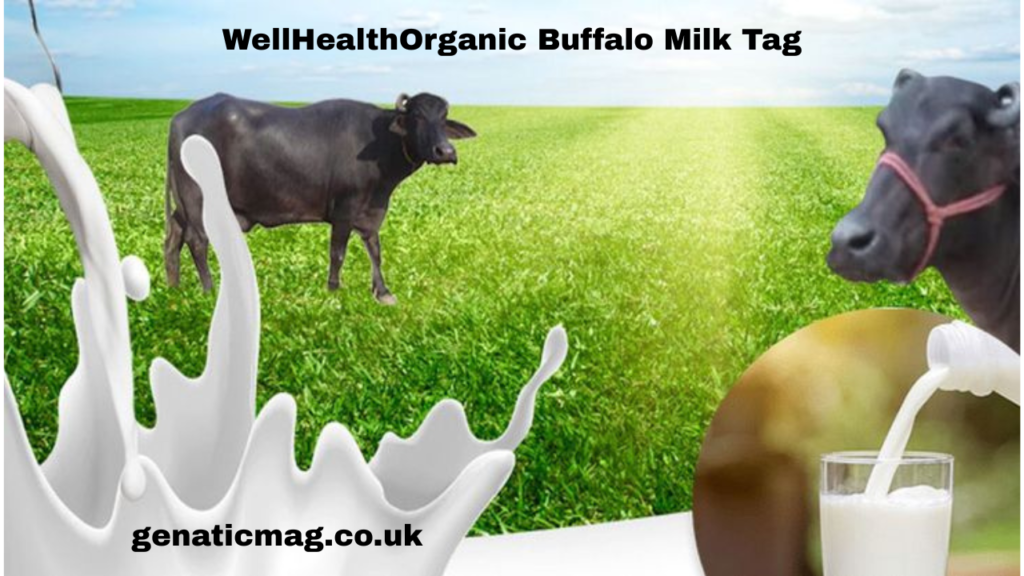Buffalo milk has long been a mainstay in traditional cuisines across Asia and beyond. But with rising knowledge about the quality of food and its source, the attention is now on WellHealthOrganic Buffalo Milk Tag—a trusted name in organic dairy farming. If you’re seeking a better knowledge of how this product connects with your nutritional needs, health objectives, and ethical lifestyle, then you’re in the perfect spot.
This comprehensive guide explores the nutritional benefits, daily usage, organic superiority, and overall impact on health of choosing WellHealthOrganic Buffalo Milk over conventional alternatives.
What Is WellHealthOrganic Buffalo Milk Tag?

The WellHealthOrganic Buffalo Milk Tag isn’t simply a brand marker—it’s a guarantee. It reflects a dedication to supplying pure, organically raised buffalo milk that is free from hazardous chemicals, hormones, antibiotics, and synthetic preservatives. This symbol serves as a guarantee of authenticity, certifying milk derived from ethically farmed buffaloes that are fed a natural, organic diet and are grown in cruelty-free circumstances.
What sets this product apart is not just its purity, but also the traditional methods used for milking, processing, and storing, which preserve the natural richness of the milk.
Nutritional Breakdown: Why Buffalo Milk?

1. Richer in Fat and Protein
About 7–8% of buffalo milk has fat, which is almost twice as much as cow’s milk. Because of its increased fat content, it has a creamier texture and is perfect for creating cheese, paneer, curd, and ghee. It also contains more protein (10–11 grams per cup), which helps with immune system function, strength development, and muscle regeneration.
2. More Calcium, Magnesium, and Phosphorus
WellHealthOrganic Buffalo Milk boasts superior mineral content. It contains 40% more calcium than cow’s milk, making it a powerful ally for bone density and skeletal health. Magnesium and phosphorus present in the milk also aid in energy production and cell repair.
3. Lower Cholesterol
Despite being high in fat, buffalo milk has lower cholesterol levels, making it suitable for individuals with cardiovascular concerns. The organic feeding practices ensure the fat is more heart-friendly and contains better lipid profiles than milk from conventional dairy setups.
4. Packed with Vitamins
Buffalo milk is a natural source of Vitamin A, B2 (Riboflavin), B12, and D, all vital for metabolic health, red blood cell formation, immune defense, and skin vitality. The WellHealthOrganic Buffalo Milk Tag ensures these nutrients are preserved naturally without fortification or chemical additives.
Health Benefits: A Wellness Ally in Everyday Life

1. Boosts Immunity Naturally
The presence of bioactive compounds, immunoglobulins, and antioxidants makes WellHealthOrganic Buffalo Milk a strong immune booster. Its antibacterial properties help protect against common infections, especially when consumed warm and fresh.
2. Enhances Digestive Health
Though buffalo milk contains more fat, it’s also known for its easier digestibility due to the structure of fat globules and the A2 beta-casein protein it naturally contains. This makes it a good alternative for those who have minor sensitivities to cow’s milk.
3. Promotes Muscle Growth and Recovery
With its high protein content and amino acid profile, WellHealthOrganic Buffalo Milk is ideal for athletes, bodybuilders, or anyone aiming to recover from strenuous physical activity. The natural growth factors in buffalo milk further support cellular repair and growth.
4. Supports Bone and Dental Strength
The superior calcium content ensures stronger bones and teeth, which is particularly crucial for children, pregnant women, and elderly individuals at risk of osteoporosis.
Usage in Daily Life: Versatile and Delicious
1. Morning Boost with a Glass of Warm Milk
Start your day with a glass of warm WellHealthOrganic Buffalo Milk—it energizes the body and enhances metabolism. Add turmeric or cardamom for an extra immunity kick.
2. Dairy Products Made Healthier
Use this milk to prepare homemade curd, paneer, and ghee, and experience the rich texture and full-bodied flavor that’s missing in regular milk. Its natural fat and protein content make dairy products more nutritious and satisfying.
3. Suitable for Cooking and Baking
From baking cakes and bread to preparing creamy sauces and desserts, WellHealthOrganic Buffalo Milk is a versatile kitchen ingredient. Its richness enhances the taste and nutritional profile of dishes without relying on artificial thickeners.
4. Ideal for Children and the Elderly
Its easy digestibility, coupled with a nutrient-dense profile, makes it especially beneficial for children’s growth and elderly bone support.
Why Choose Organic? The Ethical and Environmental Impact
Choosing milk with the WellHealthOrganic Buffalo Milk Tag also means choosing sustainability and ethics:
- Animal welfare: By avoiding hormone injections and mechanical milking, the buffaloes experience less pain and stress.
- No Hormones or Antibiotics: The milk is guaranteed to be free of any remaining poisons as there has been no exposure to synthetic medications.
- Eco-Friendly Farming: To maintain environmental balance, pastures are cultivated naturally without the use of chemical fertilizers.
By supporting such practices, you’re not only benefiting your body but also contributing to a healthier planet.
Who Should Use WellHealthOrganic Buffalo Milk?
- Health-Conscious Individuals looking for clean, unprocessed nutrition
- Fitness Enthusiasts in need of quality protein and muscle-repairing nutrients
- Children and Adolescents undergoing crucial developmental phases
- Pregnant Women who need high calcium and protein intake
- Elderly People with bone density or digestive issues
- Ethical Consumers wanting to support cruelty-free and sustainable farming
How to Store and Handle WellHealthOrganic Buffalo Milk
To maximize the benefits:
- Refrigerate Immediately upon delivery or purchase
- Consume within 2–3 days for optimal freshness
- Boil gently (if required) to avoid nutrient loss
- Store in a clean, airtight container to preserve taste and avoid contamination
Always check the WellHealthOrganic Buffalo Milk Tag to ensure you’re getting authentic organic milk.
Conclusion: More Than Just Milk—It’s a Lifestyle Choice
Selecting WellHealthOrganic Buffalo Milk is a lifestyle and health enhancement rather than just a food choice. It is one of the most comprehensive superfoods on the market today because of its unparalleled nutritional richness, health advantages, ethical sourcing, and organic purity. Whether you’re a housewife, an exercise enthusiast, or someone who practices mindful living, this milk complements your diet and improves flavor and health.
In a world where adulteration and chemical-laden food have become the norm, the WellHealthOrganic Buffalo Milk Tag: A Comprehensive Guide to Nutritional Benefits and Usage stands as a beacon of authenticity and wellness. Make the switch today—your body and your planet will thank you.
Also Read : WellHealthOrganic Buffalo Milk Tag: A Comprehensive Guide to Nutritional Benefits and Usage
